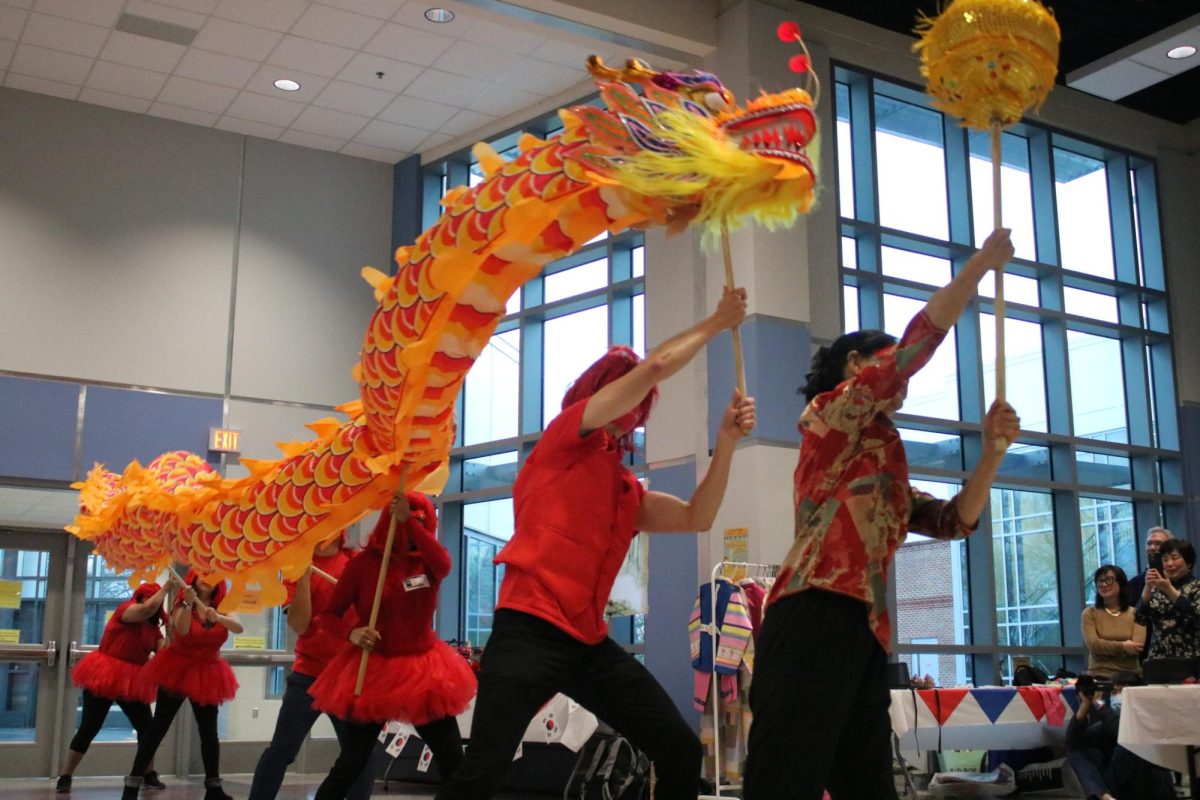The sound of traditional music, the scent of festive dishes, and the sight of a dragon with glowing red eyes flying through Nobel Commons. The Parent Teacher Student Association (PTSA) Diversity Committee hosted its third annual Lunar New Year Celebration on Friday, Feb. 2. The celebration showcased feasts and festivities for people to partake in, including traditional performances, activities, and an assortment of cultural food.
“[The Lunar New Year Celebration is a] celebration of inclusivity and diversity, fostering a sense of inclusivity and belonging for students from Asian backgrounds. It also allows students to learn more about and appreciate the traditions, customs, and cultural significance of Asian communities,” PTSA member Julia Li said. “It is a welcome break from TJ’s busy schoolwork, offering students and teachers an opportunity to come together, relax, and bond over shared cultural experiences.”
Lunar New Year marks the beginning of a new year according to the lunisolar calendar and the transition between Chinese zodiac signs. It is widely celebrated among many different Asian cultures, each characterized by unique traditions and celebrations. Those who celebrate often consider this holiday a time of the year to reunite with loved ones and embrace cultural traditions.
“My family usually makes dumplings together and buys a lot of food, ” freshman Ryan Qi said. “We eat a lot of cultural dishes that we don’t usually eat during other parts of the year.”
In the spirit of 2024 welcoming the Year of the Dragon, several student and parent performers performed dragon dances, a traditional Chinese dance typically performed during Lunar New Year and other celebrations. Being the only mythical creature of all the zodiac, the dragon is an auspicious symbol of power, luck, and strength in Chinese culture. The dance is performed to drive away evil spirits and bring good luck for the new year. Performers simulate the flowing movements of a dragon by manipulating the long puppet of a dragon using poles.
“[To practice], we just met up at a local dojo to go over certain movements with the dragon-like swerving, bopping up and down, and curling up,” senior Tommy Chen said. “At the performance, we had a lot of first-timers since we were down performers, but everyone did a great job improvising.”
In addition to the dragon dances, many students showcased their talents through other performances. These ranged from performing traditional instruments, such as the Chinese zither and Mongolian morin khuur, to performing kung fu and Chinese yo-yo acts.
“Everyone who comes to our celebrations is eager to share with and learn from one another,” PTSA Diversity Committee Chair Michele Hyde said. “The student performers awe us every time, I don’t know how they have time to develop their artistic talents on top of being such clever students.”
The celebration was also an opportunity for people to socialize and embrace different cultures with others through the various activities set up in Nobel Commons. These ranged from crafts such as paper cutting, calligraphy, and origami, to other fun activities such as taking photos in front of backdrops, trying on traditional Korean, hanbok, and playing the traditional Korean game, ddakji.
“There were culture displays with traditional Korean and Chinese clothes displayed, showcasing traditional attire from various Asian cultures that students could try on,” Li said. “Another interesting activity was learning traditional Chinese calligraphy. Students could participate in workshops or demonstrations to learn this traditional art.”
As with any other event hosted by the PTSA, the food was a hit among everyone who attended. A variety of dishes, drinks, and snacks from different cultures were served, topped off with sweet treats, fortune cookies, and red envelopes that were handed out at the end.
“Red envelopes are a very common tradition in China and other Asian countries,” Qi said. “The elderly or older people usually give children money in red envelopes to symbolize giving luck.”

![Sophomore Holly Huang twirls a ribbon as she performs her dance, “Joy of the Dragon.” Chinese ribbon dance is a traditional art form originating in ancient China. Her ribbon dance was inspired by the revered mythical creature and this year’s Chinese zodiac sign, the dragon. “My ribbon symbolized a dragon flying in the air. My outfit was [also] inspired by the dragon, the color was the same color as my ribbon, but on the shoulder there were some details like dragon scales,” Huang said. “I liked how there were a lot of people in the audience and it was just really fun to perform.”](https://www.tjtoday.org/wp-content/uploads/2024/02/IMG_0964-1-1200x774.jpg)
